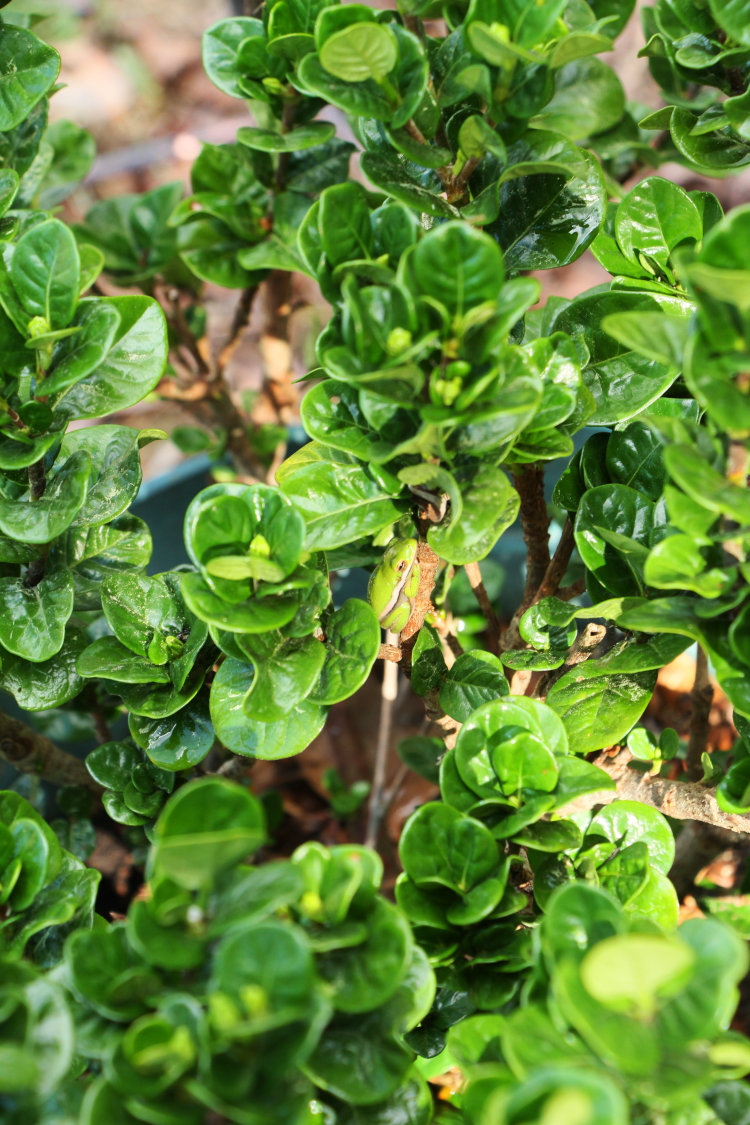Well, okay, that might be giving a slightly overblown idea of the efforts, since all but one of these images were taken within seven meters of the front door here at Walkabout Estates. The one exception? Within seven meters of the back door. But I have a few spring photos handy and I’m gonna use them (in between more raptor images, so there’s a dual purpose.)
We’ll start with one of the potted gardenia bushes.

This dates back about two weeks now, but The Girlfriend’s diamond spire gardenias (Gardenia hybrid ‘Leefive’ PPIP, no, really,) were among the first to be moved out of the greenhouses – they’re probably quite cold hardy, but being potted, they’re susceptible to root freeze if the temperature remains cold enough, so they were in the ‘adjunct’ greenhouse for safety. Yet, there’s an additional reason that I took this photo – can you spot it?
Fine – we’ll go a little closer.

I mean, I wasn’t making it hard on you, so I was skilllessly (that’s a word, right? It should be anyway,) placing the subject dead-center, and it’s only the contrast of natural bright sunlight that makes it harder.
How about now?

The coloration is working pretty well, I admit, even if it is a bit too bright for true blending, but this little spud didn’t waste any time, and indeed, used this plant as a routine daytime perch until recently.

Featured here only about a billion times, I still feel obligated to inform new readers that this is a juvenile green treefrog (Dryophytes cinereus,) less than half adult size. It had to endure a couple of pretty chilly nights since its first appearance on the plant, but I think we’re past that point now.
And then, I didn’t spot it for two days, but that’s likely because I moved more plants from the greenhouses in the interim, and the frog decided it liked another choice better.

We have two potted, unidentified hydrangea bushes, one of which is immediately adjacent to the previous gardenia, and the frog elected to move to that, blending in even better, plus the leaves are much larger and offer better shelter.
I know you’re saying these aren’t a match and this is another green treefrog, because of those spots on the back, but they’re concentrated on the left side, which we really weren’t seeing in the other pics, while there remains some evidence of them in the full-resolution versions too, so I’m comfortable telling you you’re wrong.
[This is a curious trait: yellow spots are fairly common on green treefrogs but by no means a routine marking, and they appear to be entirely random – no pattern or bi-lateral symmetry (matching left and right) to them. Something I’ll have to look up sometime.]
The sequence of photos of the gardenia came from two weeks ago, while the one above on the hydrangea comes from this morning – as does this one:

Next to both of those plants sits one of the three butterfly bushes (Buddleia davidii,) and an occupant thereof wasted no time in snagging a meal, especially since the bush is not even close to flowering yet. I can’t identify this crab spider, except for Family (Thomisidae,) nor can I identify the capture, though from the eyes and a peek at the mandibles, I’m inclined to say it’s the flying stage of some ant species (Formicidae) rather than a wasp or other Hymenoptera. Regardless, they’re both quite small, and this was taken with the reversed 28-105. Knowing spiders the way I do, I suspect that this guy (and another nearby) did not actually happen upon the butterfly bush when I put it out, but remained on it from last year, just waiting for warmer weather and the reappearance of prey insects.
A quick sideline, back to two weeks ago.

This is one of many almonds developing on my almond tree, which is doing very well this year. Last year, we also had some almonds coming in but then something, likely squirrels, stripped them all off, despite being heavily coated with deer repellent, which I would have thought would work on squirrels too because it’s pretty nasty stuff. We’ll see what happens this year, but so far, so good.
And finally,

By this time last year, I’d witnessed a serious territorial battle among the Carolina anoles (Anolis carolinensis,) but it seems slower this year – or I just haven’t witnessed them, which is entirely likely. But this one was sunning itself on a fence post a few days back, and judging from that girth with the narrow tail, I’m considering this a pregnant female. I mean, not to her face – I was prudent and kept my mouth shut, because this is The South in the US and this may be par for the course. The worst bit is, there’s no way I’ll know for sure, because if she is preggers, she’ll find some leaf litter to deposit her eggs within and I won’t see the young for weeks, perhaps months. Plus I have no way of differentiating anoles anyway, so watching for this one specifically to see if the belly suddenly vanishes is a pointless exercise. Regardless, we’ll probably see bebbies soon enough, from this one or others because there are plenty on Walkabout Estates. Right not I’m still watching for some of last year’s juveniles, and the forked tail one. Not lofty goals, but goals nonetheless.
[Actually, it certanly is ‘theless,’ isn’t it? Whatevs.)




















































